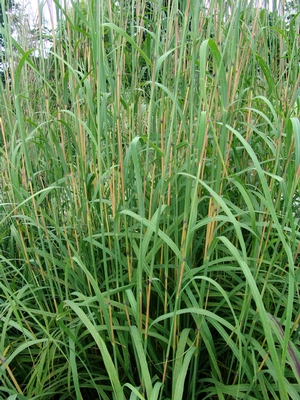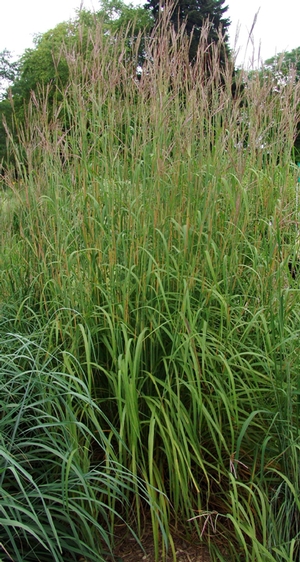Andropogon gerardii
Common: big bluestemAndropogon gerardii LP50 - 50 per flat
- Height: 4'-8'
- Spread: 4'-5'
- Spacing: 24"
- Hardiness Zone(s): 4-9


Andropogon gerardii LP50 - 50 per flat

The king of native grasses, big bluestem has handsome gray to blue-green stems in spring, turning to green alternating with deep red in summer, then to coppery red in fall. Three-fingered seed heads top tall stems in August. Clump forming with excellent drought tolerance once established. Found naturally in moist meadows and along side roads and rivers from Canada to Mexico.
Very tolerant of diverse conditions, but is most often found in full sun, dry and sandy to clay soils. It grows quickly in moist, fertile soils, but is more likely to bend and fall over. Clumps can be divided in early summer, but bring a sturdy shovel!
The king of native prairie grasses, big bluestem is a tall, warm season bunch grass with handsome gray to blue-green stems in spring, turning to green alternating with deep red in summer, then to coppery red in fall. Three-fingered seed heads top tall stems in August. Once established, its fibrous root system can become quite extensive, contributing to its drought tolerance and erosion control value.
Andropogon gerardii once dominated the tall-grass prairies of North America, from the Rocky Mountains to the east coast. According to the US Forest Service it often dominated 70 to 90% of vegetation throughout these prairies. It has been found in a variety of soil types and moisture levels throughout the US, but stand tallest in full sun and drier soils.
In our trial gardens, Andropogon gerardii is a striking ornamental grass with no need for irrigation even in the most extreme drought. In our display gardens it shows off its fall color and structure. In our tall mesic meadow, it is a long-lived compliment to its fellow prairie grasses and forbs.
Andropogon gerardii is valuable to a range of insects, birds and mammals. Its foliage is important forage for voles, livestock and insects such as skippers, grasshoppers and katydids. Its seed is food for several sparrow species.